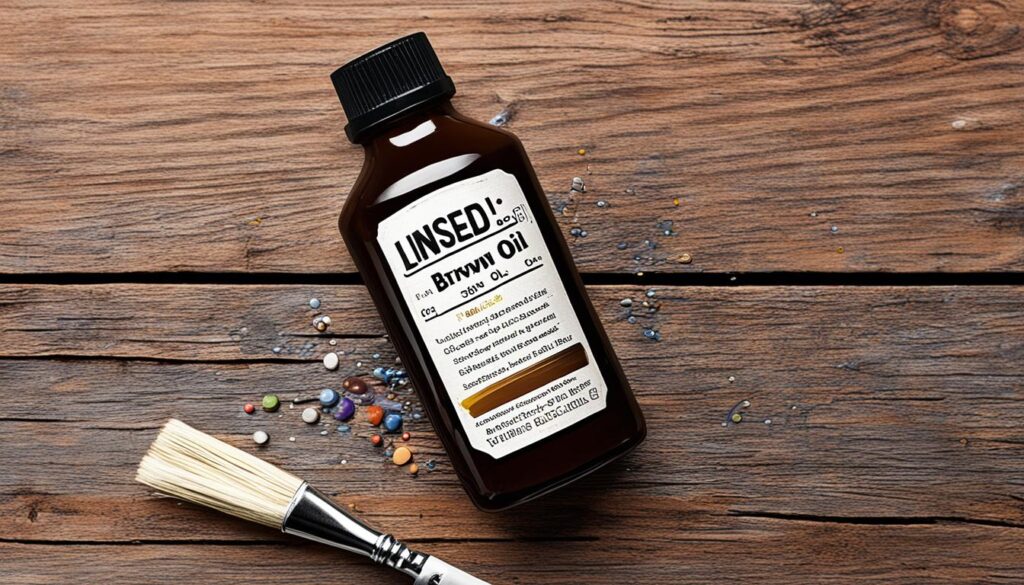Wood finishing enthusiasts have debated mixing polyurethane with boiled linseed oil (BLO). Discussions have surged, with a forum post hitting over 35,000 views and 21 users chiming in. Clearly, many are curious about this blend.1
The blend seems promising as some have tested it successfully. They thinned polyurethane with mineral spirits and achieved a smooth finish. Yet, there are several tips to remember.1
Experts confirm this method can be effective but warn about the timing. BLO must fully cure, needing a day or more, to form a solid base for the polyurethane. This step is vital for the finishes to stick together well.2
Adding to this, the choice of polyurethane matters. Water-based polyurethane doesn’t mix well with BLO. But using oil–based polyurethane over fully cured BLO can create a strong, lasting finish.2
Knowing how to blend polyurethane with BLO can enhance woodworking projects. It allows for a beautiful finish while avoiding common issues.
The Compatibility of Polyurethane and Boiled Linseed Oil
Sources say that polyurethane and boiled linseed oil (BLO) can work together. But, the BLO must be fully dry before adding polyurethane.2 One source mentions using oil–based polyurethane over BLO. They sometimes thin the polyurethane with mineral spirits.3 A different source warns that water-based polyurethane might not work well with BLO. It could lead to sticking problems. But, oil–based polyurethane can go over BLO if it’s cured. The sources agree on letting the BLO dry enough, at least a day, before adding polyurethane.
| Oil Type | Iodine Value | Drying/Non-Drying |
|---|---|---|
| Tung oil | 163-173 | Drying |
| Walnut oil | 120-155 | Drying |
| Linseed oil | 136-178 | Drying |
| Mineral oil | 0 | Non-Drying |
| Coconut oil | 7-10 | Non-Drying |
| Palm oil | 16-19 | Non-Drying |
3 An oil with an iodine number below 115 doesn’t dry well.3 Always check if an oil is a drying type before you seal with lacquer or polyurethane.3 How long it takes for oil to fully dry can change. The time depends on the weather.3 Non-drying oils, such as mineral oil, won’t work with lacquer or polyurethane, even if you wait.
can you put polyurethane over boiled linseed oil
It is doable to coat polyurethane over boiled linseed oil (BLO). But, there are some key points to remember. Users combine them well, sometimes thinning the polyurethane with mineral spirits.1 The third source says that oil-based polyurethane is fine over cured BLO. Yet, water-based poly will not work well and can lead to sticking issues.2 Be sure the BLO dries completely, which might need a day or more, before you add the polyurethane.1
One user suggests mixing the oil-based polyurethane half and half with mineral spirits if applying over BLO.1 Another advises a combo for heavy-use spots like tables: boiled linseed oil finish, followed by dewaxed shellac and several coats of Minwax wipe-on polyurethane. Also, it’s noted that the BLO may need more than a week to fully dry, based on air moisture and warmth.1
Though BLO and water-based poly don’t get along, pros often use pre-cat lacquer over BLO for its strength and easy use.2 Shellac works too as a shield to prevent issues with other coatings.2 And a mix of oil-based urethane, Danish oil, and naphtha makes a tough finish on BLO.2
| Finishing Technique | Compatibility with Boiled Linseed Oil | Advantages |
|---|---|---|
| Oil-based Polyurethane | Compatible, when applied over fully cured BLO | Provides a durable, protective topcoat |
| Water-based Polyurethane | Not compatible, can cause adhesion issues | N/A |
| Pre-cat Lacquer | Recommended for use over BLO | Offers durability and ease of application |
| Shellac | Can be used as a barrier coat over BLO | Prevents compatibility issues with certain topcoats |
| Oil-based Urethane, Danish Oil, and Naphtha | Creates a durable finish over BLO | Produces a long-lasting, protective coating |
So, the mix of polyurethane and BLO can work, with attention and preparation. By using tips from the sources, woodworkers can get a finish that’s both lovely and lasting, enhancing the wood’s true look.
Enhancing the Natural Beauty of Wood
Boiled linseed oil (BLO) is great for making wood look better. It brings out the wood’s true color.4 Other oils, like Minwax Antique Oil or Watco Danish Oil, can make the grain stand out. BLO gives wood a warm tone, perfect before adding a protective coat like polyurethane.
Oils made from linseed, soy, or paraffin soak into the wood. They make it look nicer, but they might get sticky.4 On the flip side, Polymerized Tung Oil is tough, repels water, and stays strong against foods and drinks.4 It helps wood keep its unique look without getting sticky.4 This special oil makes wood waterproof and tough.
Oil finishes show off the wood’s color and pattern more than water finishes.5 General Finishes makes Seal-A-Cell Clear to highlight the wood’s natural color and Arm-R-Seal to protect it.5 The Enduro-Var by General Finishes looks like a mix of oil and varnish. It stays strong, but it doesn’t work well with shellac.5

Application Methods for a Flawless Finish
Experts share tips for a perfect finish when using polyurethane over boiled linseed oil (BLO). First, thin the oil-based polyurethane with mineral spirits by half6. Then, apply dewaxed shellac right after the BLO. This will help the oil dry and make it tougher. Make sure the BLO fully dries, which takes a day or more, before adding the polyurethane topcoat6. Sanding well is also key to a smooth finish.
| Finishing Technique | Benefits | Considerations |
|---|---|---|
| Thinning oil-based polyurethane with mineral spirits | Easier application, faster drying time | Requires proper ventilation, potential for increased VOC emissions |
| Applying dewaxed shellac over BLO | Helps dry the oil, adds a layer of toughness | Requires additional prep work, may impact final appearance |
| Allowing at least 24 hours of drying time for BLO | Ensures proper curing before polyurethane application | Patience and planning required, project timeline may be extended |
| Thorough surface preparation (sanding) | Creates a smooth, uniform surface for finish application | Extra time and effort required, potential for dust during sanding |
Woodworkers can make their projects perfect by using these steps and tips. They help create a top-notch finish when mixing polyurethane with boiled linseed oil.
Alternatives to the Polyurethane and BLO Combination
Looking for other options besides putting polyurethane over boiled linseed oil (BLO)? Some suggest Minwax Antique Oil or Watco Danish Oil. They enhance wood’s natural color and grain.1 A pro’s finish mix includes BLO, raw tung oil, and satin polyurethane.1 Using dewaxed shellac or oil-based varnishes is also mentioned as good steps.
Want a finish that lasts through temperature changes? Try spar varnishes with alkyd resins over BLO.7 Shellac keeps moisture out but gets milky outdoors.7 Adding UV protection to outdoor finishes helps wood last longer. But, it won’t block all UV rays completely.
A mix of BLO, oil-based polyurethane, and mineral spirits is another choice. This mixture in a mason jar gives a clear, warm look.6 Apply the first coat thickly, then wipe off extra before it gets sticky. Let each coat dry for 24 hours.6
| Finish Formula | Key Ingredients | Characteristics |
|---|---|---|
| Minwax Antique Oil or Watco Danish Oil | Linseed oil, tung oil, varnish | Enhances natural wood color and grain |
| 1/3 BLO, 1/3 raw tung oil, 1/3 satin polyurethane | Boiled linseed oil, raw tung oil, polyurethane | Professional-grade durable finish |
| 1/3 BLO, 1/3 oil-based polyurethane, 1/3 mineral spirits | Boiled linseed oil, oil-based polyurethane, mineral spirits | Clear satin spar varnish look with warm amber hue |
These options help get the look and durability you want. Whether it’s a natural finish or a more protective one.1 Trying different methods can help you find the best finish for your project. One that shows off the wood’s beauty and fits your needs.
Maintaining and Refreshing the Finish
The sources give tips on keeping the finish great when you mix3 polyurethane with boiled linseed oil (BLO). One person says to add many layers of Minwax wipe-on polyurethane over your BLO and shellac on things like table tops. If something doesn’t get used a lot, they recommend using a furniture wax finish on it.
Another person shares a tip for touching up the finish from time to time. They suggest a mix of BLO, mineral spirits, and polyurethane. This keeps your surfaces looking good and protected over time.
By following these steps, people who work with wood can keep their finishes looking new. Regularly adding a topcoat and sometimes using the BLO mix again helps. It keeps the wood’s look fresh and guards against damage and the elements.
Expert Tips and Tricks
When mixing polyurethane with boiled linseed oil (BLO), tips from experts can help. Mix oil-based polyurethane with mineral spirits 50/50 for better flow.1 Also, try adding a coat of dewaxed shellac after BLO. It makes the oil dry quicker and adds toughness.1
Want a smooth finish? Let the BLO dry well for a day or more before the polyurethane.1 Smooth surfaces are crucial too. They recommend thorough sanding for a flawless outcome.1
If you aim to improve wood beauty, consider Minwax Antique Oil or Watco Danish Oil with or instead of BLO.8 These oils make the wood’s color stand out. It’s before you apply polyurethane.8
A pro tip offers a blend of BLO, raw tung oil, and satin polyurethane for a great finish.1 This mixture gives a strong and good-looking finish.14
For sticking concerns, a dewaxed shellac layer between BLO and polyurethane is advised.1 It helps layers adhere well.1
The secret to a fine finish with polyurethane and BLO is right prep and dry times. Also, explore with application and finishing methods that suit your project.148
Achieving Your Desired Look and Durability
Combining polyurethane and boiled linseed oil (BLO) for a wood finish lets you balance beauty and protection.9 BLO makes the wood’s colors rich and “pop.”9 But, it’s not the most durable. So, a layer of polyurethane is often used for extra shield.
For the best result, put on a few BLO coats first. Let them fully dry. Then, add a thinned oil-based polyurethane layer.10 This keeps the wood looking natural and adds a tough layer. It fights off scratches and keeps the wood looking good.10 Make sure to clean and sand well before the polyurethane to help it stick right.
If you like a clear finish, try a dewaxed shellac between BLO and polyurethane.10 This makes the topcoat smoother and more even.10 You can also try other oil-based finishes like Minwax Antique Oil or Watco Danish Oil. They give a natural look with less drying time than BLO.9
Source Links
- https://www.lumberjocks.com/threads/boiled-linseed-oil-and-polyurethane.172322/
- https://woodweb.com/knowledge_base/WaterBased_Polyurethane_Over_Boiled_Linseed_Oil.html
- https://kingsfinewoodworking.com/blogs/news/can-i-apply-lacquer-or-polyurethane-over-an-oil-finish
- https://ncwoodworker.net/forums/index.php?threads/blo-poly-why-mix.20449/
- https://generalfinishes.com/blog/what-best-clear-finish-to-bring-out-natural-color-and-characteristics-wood-grain
- https://www.anneofalltrades.com/blog/2021/1/22/3-ingredient-furniture-finish
- https://discuss.inventables.com/t/boiled-linseed-oil-what-everyone-uses/14394
- https://www.rimfirecentral.com/threads/finish-over-boiled-linseed-oil.492551/post-4459087
- https://sawmillcreek.org/showthread.php?184891-Boiled-Linseed-Oil
- https://www.lumberjocks.com/threads/finishing-using-linseed-oil.60968/
Welcome to WoodCraftYard.com, your one-stop destination for all things woodworking! I’m Oliver Candler, a dedicated woodworking aficionado and the creative mind behind this virtual woodworking haven. With a deep-rooted love for craftsmanship and a keen eye for detail, I am on a mission to share my passion for woodworking with fellow enthusiasts like yourself.
As a seasoned woodworker, I am committed to providing you with valuable insights, practical tips, and inspiring project ideas to help you unleash your creativity and master the art of woodworking. Whether you’re a seasoned pro or just starting out on your woodworking journey, join me as we carve, sand, and saw our way through the world of woodworking together.
Let’s embark on this woodworking adventure, where every knot, grain, and finish tells a unique story. Together, let’s craft, create, and build something truly extraordinary at WoodCraftYard.com!

